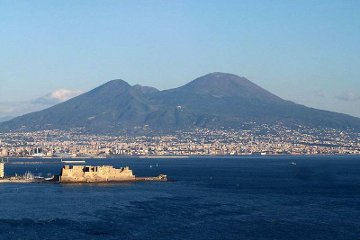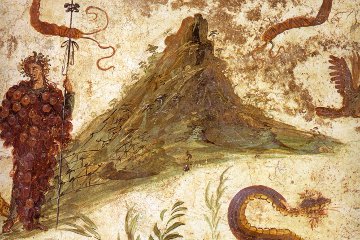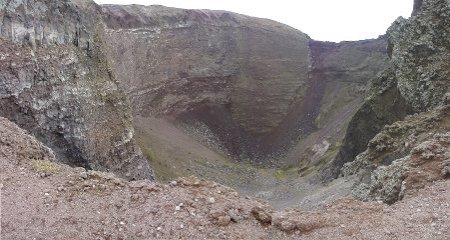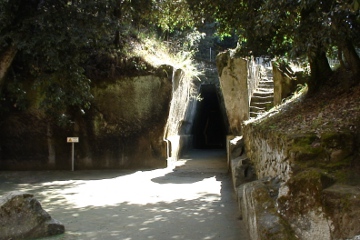The Phlegraean Fields
| Vesuvius | 40 49 16.87N 14 25 36.04E | The outer circle of Monte Somma is clearly visible to the north of the modern crater. |
| Phlegraean Fields | 40 49 37.88N 14 08 19.61E | The crater of Solfatara in the Phrelgraean Fields. |
| Cumae | 40 50 52.23N 14 03 07.44E | Cumae is built on a hill overlooking the sea. The Sibyl's tunnel is near the foot of the hill towards the south-east. |
When we toured Greece and Italy a few years ago we travelled around Sicily and were then faced with the problem of getting up to Naples. Having drive across the boot of Italy, we were satiated (to put it politely) with bus travel, but neither were we keen on taking to the air for the short hop from Palermo to Naples. Instead we decided to sail the Tyrrhenian Sea by catching a ferry in Palermo and disembarking in Naples.
The ferry itself was something of a disappointment. We had arrived in Italy via the Greek ferry from Patras to Brindisi. The ship was spotless, the dining room excellent, the staff friendly and the disembarkation time convenient, so we were looking forward to another sea voyage. Alas, the Italian ferry was dirty, the rooms cramped, the food apalling and the staff were unhelpful, to say the least. What was worse, the ship arrived in Naples while it was still dark and the bus that should have met us had gone off on a trip somewhere else and the travel agent was asleep and not answering his phone.
We stood on the deserted dockside for nearly an hour, while a freezing wind whipped around us and various nautical things clanked and sloshed drearily. What was worse was that the cafes and restaurants at Pompeii were all booked up and breakfast was a horribly patchy affair of whatever we could get out of a mini-market - and that wasn't much.
Fortunately the day improved from there on; the guide turned out to be a vivacious young lady, the rain clouds cleared away and we got some decent photographs in Pompeii, the brothel was open, so the tour group was happy, and a general good time was had by all. We then drove the short distance to Herculaneum and again everything went well. The ruins were interesting and not too crowded, the sun shone warmly, the guide was informative.

| |
| The Bay of Naples and Vesuvius. The modern summit is to the right, Monte Somma is on the left. |
The next item on the agenda was to climb Mt Vesuvius. Our coach took us a short distance along the autostrada and then turned off and began to climb through suburban streets lined with decaying Italian houses. After a short while, however, these died away and the road began to zigzag through open countryside and it was about then that we noticed the swathes of black ash and burned red rock which lined the road and, in places, had obviously once covered it. Conversation died away and cameras began to click in earnest.
Then the road levelled off and we came round a corner. To the right the road began to climb again as steeply as before, but straight in front of us was an enormous valley that curved round the mountain and out of sight. The right-hand side of the valley was the huge cone of Vesuvius; the left-hand side was clearly and obviously the shattered remains of a super-mountain and we realised that the modern volcano was merely a cone that had grown up inside the broken caldera of this much larger volcano.

| |
| A fresco believed to represent Vesuvius, from the House of the Centenary in Pompeii |
Conversation with the guide later on revealed that this older and larger volcano is known as Monte Somma. A fresco in the "House of the Centenary" in Pompeii depicts Mt Vesuvius as a single cone, suggesting that Monte Somma may represent the remains of the mountain which destroyed Pompeii. The present summit cone of Vesuvius has built up inside the Monte Somma caldera in the two thousand years since AD 79.
The bus took us to within six hundred feet of the summit, after which we had to climb up a path over the ash and cinders of the volcanic cone. One or two of the younger, brisker members of the group shot ahead of the rest of us and jogged round the entire circumference of the crater. The rest of us were content to reach a point from which we could look down into the yawning chasm of the crater, vaguely disappointed that it all seemed so quiet and peaceful. There were no wisps of steam, no whiffs of sulphur, just an inverted cone with steep, rocky sides.

| |
| Looking down into the crater of Mt Vesuvius. |
Postcards on sale in kiosks at the summit told a different story and showed the crater full of red-hot magma to within a foot or two of the spot where we stood. Indeed, only a little further and we found the remains of the famous funicular railway (immortalised in the song "Funiculi Funicula") that had been destroyed by an eruption at the time of the Second World War.
Well content with our day's activity we retreated down the mountain and headed for our hotel in the heart of Naples. Those who still had any energy left then accompanied me to the Naples Museum where we spent what was left of the afternoon sheltering from the heavy rain and wandering around the fabulous exhibits (including the Secret Chamber, as described elsewhere on this site).
I was very gratified with the day, for although I had visited the ruined cities before, I had never had the chance to climb Vesuvius, so that was a dream come true. However the following day was to be another dream fulfilled, for the itinerary that I had created called for us to visit Cumae, home of the Sibyl, and the road would take us through the Phlegraean Fields - the Burning Fields.
According to legend, it was possible to walk across these fields with a torch and set fire to holes in the ground and you could surround yourself with jets of flame. More prosaically, the ground is littered with 24 craters and even more fumaroles from which steam streams into the air along with gusts of sulphur-laden volcanic air. One crater is large enough to form a lake, Lake Avernus; an 8-day eruption in 1538 gave rise to Monte Nuovo, a hill which has grown by ten feet since 1970 and conceals a volcano that the experts claim could one day explode with the ferocity of Mt Tambora in Indonesia.
The Phlegraean Fields are the visible sign of a massive caldera, most of which lies beneath the blue waters of the Bay of Naples. At just over 8 miles in diameter, the caldera puts the puny Vesuvius crater to shame. If it should erupt, the resulting explosion could wipe out the whole of Naples or, if the worst-case scenario happened, make the whole of continental Europe temporarily uninhabitable!
In an attempt to understand what is going on beneath Monte Nuovo, British volcanologist Christ Kilburn wants to drill a hole two and a half miles deep to bring up samples of the rock. Although the hole would stop two miles short of where the magma reservoir is believed to lie, the proposal has filled the Neapolitans with panic. Local geochemist Benedetto de Vivo claims that the mere act of drilling the hole could trigger the feared eruption and his warnings of doom have just enough precedent that the mayor of Naples, under pressure from the Italian press and his electors, has ordered plans for drilling to be suspended while further technical reports are prepared.
As we drove along the autostrada towards Cumae we certainly saw piles of lava and cinders and caught glimpses of steam or smoke, but I was rather disappointed by the Phlegraean Fields, which appear to be prime real estate for house building - a folly only exceeded by that of the inhabitants of the western United States of America who build luxury houses on top of earthquake faults and then seem surprised when they are knocked down.
I suppose, however, that the Italians do have the excuse that people have been building here for thousands of years. The ancient Romans were attracted by the free hot water for their baths and Baiae (now submerged beneath the sea) was a popular reosrt where Julius Caesar, Nero and Hadrian had villas. Agrippina the Elder and Scipio Africanus are buried here, and the third largest amphitheatre in the ancient world was built here to cater to the immense demand for entertainment.
We could have spent all day exploring these and other ancient remains, but time pressed and all we saw was the ruins of Cumae where Aenaeas, the founder of Rome, visited the Sibyl. Although there was a Sibyl at Delphi, the Cumaean Sibyl was probably the most famous of the four, simply because of her links with Aenaeas and Rome. As described in Virgil's Aeneid, the hero wanted to visit his father Anchises in the underworld and the Sibyl guides him down into Hades and provides the secret knowledge that persuades Charon to ferry him across the River of Death.

| |
| The entrance to the tunnel which leads down to the Cave of the Sibyl, one of the entrances into Hades. |
We were fascinated to discover a tunnel cut into the soft tufa rock of Cumae, descending steeply for 425' to a small chamber which Amedeo Maiuri, who discovered the tunnel in 1932, identified as the cave of the Sibyl. (Some now claim that it is a Christian burial chamber.) To our surprise this chamber was not deep under the hill as we had supposed, for the tunnel is cut parallel to the side of the hill and there is a hole through which daylight illumines the final part of the tunnel. Nevertheless, anyone who wished to consult the Sibyl would be sufficiently disorientated by the long descent that he or she might well believe that they had gone down into Hades.
Elsewhere the poisonous gasses that come up from the ground are sufficiently intense that birds which roost nearby drop dead, another indication that the Phlegraean Fields were close to Hades, the realm of Death. It is possible that the never-ceasing fire of the Burning Fields, the smell of brimstone (another name for sulphur) and the sight of sulphur-caked rocks may be behind some of the imagery of never-ending "fire and brimstone" found in the book of Revelation.
In the finale of that book, the wicked are cast into a lake of fire and Hades itself is destroyed in the same conflagration. If Benedetto de Vivo is right and the huge volcano that lies beneath the Phlegraean Fields does explode, Hades - the Cumaean version, anyway - will vanish in a huge outpouring of fire and brimstone.
Cumaean Sibyl According to legend, Apollo fell in love with the girl and offered her anything she pleased in exchange for a night of passion. Sibyl demanded eternal life (some say she picked up a handful of sand and asked for as many years as she held grains of sand), but she neglected to ask for eternal youth as well, with the result that she grew older and smaller until finally she was kept in a glass bottle to save her from being blown away. Trimalchio, in The Satyricon by Petronius, claimed, "I saw the Sibyl at Cumae with my own eyes hanging in a jar; and when boys cried to her, 'Sibyl, what do you want?' she answered, 'I want to die!'" Eventually she grew so small that only her voice was left.
The Aeneid describes how the Sibyl gave her prophecies by writing on leaves - one word per leaf. The leaves were laid down in order at the door of the Sibyl's cave, but if the wind jumbled them up, the Sibyl would not help to put them in order again, which caused some to misinterpret the Sibyl's predictions and others to deride her as a made prophetess.
The Cumaean Sibyl was the origin of the Sibylline Books, which were offered to Tarquinus Superbus by an unknown old woman. She asked an exorbitant price for the nine volumes, promising that they would give vital advice and guidance to his kingdom. When Tarquin indignantly refused, because they were too expensive, she burned three of the books and offered the remaining six for the same price. Again Tarquin refused and she then burned three more before offering the surviving three for the same price. This time Tarquin gave in and paid what she demanded.
The books were kept in the Temple of Jupiter on the Capitol and were consulted only in emergencies. However the temple burned to the ground in 80 BC and the mystic books were destroyed. An empire-wide effort was made to collect all the sayings of all the Sibyls and Augustus moved them to the temple of Apollo on the Palatine, but in AD 405 Stilicho, a barbarian general who was the real ruler of Rome, ordered them burned on the basis that they were pagan and the empire was now Christian. Return
close to Hades At Hierapolis, a short distance from Laodicea in Turkey, there is another entrance to Hades where the doorway is blocked by barbed wire and notices warning "Danger", for carbon monoxide of volcanic origin still fills the passageway. Return
<© Kendall K. Down 2011





